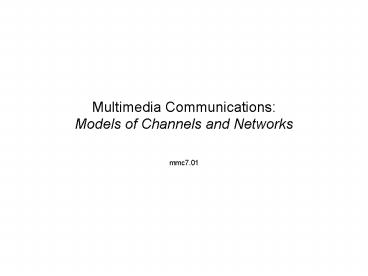Multimedia Communications: Models of Channels and Networks PowerPoint PPT Presentation
1 / 24
Title: Multimedia Communications: Models of Channels and Networks
1
Multimedia CommunicationsModels of Channels and
Networks
- mmc7.01
2
Benefits of Models
Simplification of Complex Problems Scientific
Understanding of Performance and Fundamental
Limits Simulations of Systems Comparisons and
Calibrations of Algorithms
mmc7.02
3
Examples of Models in Communications
Analog Digital Channels Shannons
Formula Bit Errors Signal
Power Networks Multimedia Traffic Packet
Losses OSI Model Sources
Entropy Activity Error
Sensitivity Users Mobility Interactivity
mmc7.03
4
Shannons Formula
C W log (1 SNR) where C channel
capacity W channel bandwidth
SNR signal-to-noise ratio log base 2
mmc7.04
5
Shannons Limit on Error Rate
mmc7.05
6
Signal Power Model0.375 inch CoAx Cable
mmc7.06 Ahamed and Lawrence 97
7
Signal Power ModelWireless Channel
mmc7.07 Goodman 97
8
Multipath Fading
mmc 7.08 Steele 92
9
Multipath Fading Models
K Fraction of Power in Dominant Path
mmc 7.09 Steele 92
10
Interference Models
- Adjacent Channel Interference Minimized in
Cellular Radio Significant in AM and FM Radio - Co-Channel Interference Minimized in
Cellular Radio Non-negligible in AM and FM
Radio - Often modeled as noise in CDMA, Cable Systems
- Advanced techniques use interference cancellation
mmc7.10
11
Cellular Radio Plan
mmc7.11 Goodman 77
12
Gilbert Model for Bursty Errors
Prob (losing block) PGB / (PBG PGB)
mmc7.12
13
Network Traffic Models
Systematic Patterns Long Term and Short Term
Variations Poisson Model Autoregressive
Model Self-similar (Fractal) Model Dependence on
Media and Media Compression
mmc7.13
14
Packet Voice Modeling
Two-state model
?
Talk spurt (active)
Silence (inactive)
?
15
Packet Voice Modeling
Composite model for N multiplexed voice sources
...
...
Probability that i sources are active at the same
time
16
Markov Model
17
Markov Model
? M 0
18
Poisson Process
- Oldest traffic model
- Inter-arrival times exponentially distributed
- An Inter-arrival times
- Counting process satisfying
- N(t) Number of arrivals in an interval of length
t - The number of arrivals in disjoin intervals is
statistically independent
19
Video Traffic Modeling
First-order autoregressive model
Where ?(n) bit rate (bits/pixel) of frame
n w(n) stationary i.i.d. WGN with Ew ? a, b
constants
20
Video Traffic Modeling
- Advantages of first-order autoregressive model
- Simple representation of coded video sources
statistics - Resembles the statistics of videoconference/videop
hone signals - Disadvantages
- Cannot be readily applied to the determination of
network parameters (buffer sizes, delays) - Does not capture the effect of scene change in
video sequences - Solution Markov-Modulated Poisson Process (MMPP)
21
Source Models
Unequal error-sensitivity Unequal
delay-sensitivity Unequal priority Constant
Quality-Variable Bit Rate Constant Bit Rate-
Variable Quality Adaptive Bit Rate
mmc7.14
22
QoS Models
Best Effort Guaranteed QoS
mmc7.15
23
User Models
Up-link and Down-link Usage Interactivity Patience
and Attention Span Quality on Demand
mmc7.16
24
Open System Interconnect Model
- Application Layer
- Presentation Layer
- Session Layer
- Transport Layer
- Network Layer
- Data Link Layer
- Physical Layer
mmc7.17

